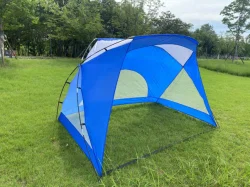Camping tents and canopies are essential shelters for outdoor enthusiasts
2024-04-24
Camping tents and canopies are essential shelters for outdoor enthusiasts, providing protection from the elements and a comfortable place to rest while camping, hiking, or engaging in other outdoor activities. Here's an overview of these items:
1. Camping Tents:
- Types: Camping tents come in various types and designs to suit different camping needs and preferences. Common types include dome tents, cabin tents, tunnel tents, backpacking tents, and pop-up tents.
- Capacity: Tents are available in different sizes to accommodate varying numbers of occupants, ranging from solo tents for one person to large family tents that can sleep six or more people.
- Features: Modern camping tents often include features such as waterproof or water-resistant materials, ventilation windows or vents for airflow, built-in storage pockets, removable rainflies, and easy-to-assemble designs with color-coded poles or clips.
- Seasonality: Tents are categorized by seasonality, with options for three-season tents suitable for spring, summer, and fall camping, and four-season tents designed for use in all weather conditions, including winter camping in snow and cold temperatures.
- Materials: Tents are typically made of durable materials such as polyester or nylon for the tent body, with reinforced floors and waterproof coatings to keep occupants dry during rain or inclement weather.
2. Canopies:
- Types: Canopies, also known as shade shelters or gazebos, are freestanding structures designed to provide shade and shelter from the sun, rain, and wind. They come in various styles, including pop-up canopies, beach canopies, and event tents.
- Uses: Canopies are versatile and can be used for camping, picnics, beach outings, outdoor events, tailgating, and backyard gatherings. They provide a shaded area for relaxing, dining, or socializing outdoors.
- Features: Canopies often feature lightweight and portable designs with collapsible frames for easy setup and takedown. They may include features such as adjustable height settings, removable sidewalls or screens, UV protection, and water-resistant canopies or tarps.
- Materials: Canopies are typically constructed of lightweight yet durable materials such as polyester or polyethylene for the canopy fabric, with powder-coated steel or aluminum frames for stability and strength.
When choosing camping tents and canopies, consider factors such as size, capacity, seasonality, ease of setup, durability, and portability to meet your specific camping needs and preferences. Additionally, proper care and maintenance, including regular cleaning, storage, and repair of tents and canopies, can help prolong their lifespan and ensure enjoyable outdoor experiences for years to come.



